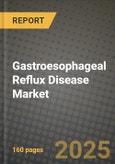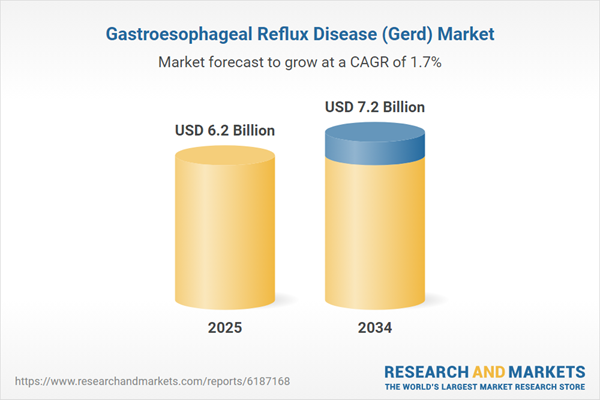Gastroesophageal Reflux Disease (GERD) Market Overview
The Gastroesophageal Reflux Disease (GERD) Market is experiencing steady growth, driven by the increasing prevalence of acid reflux disorders worldwide. GERD, a chronic condition where stomach acid frequently flows back into the esophagus, affects millions globally and has become a significant health concern due to lifestyle changes, dietary habits, and rising obesity rates. The market consists of pharmaceutical treatments such as proton pump inhibitors (PPIs), H2-receptor antagonists, and antacids, as well as medical devices and surgical interventions for severe cases. The growing awareness about GERD’s long-term complications, including esophagitis and Barrett’s esophagus, has led to an increased demand for early diagnosis and effective treatment options. With advancements in drug formulations and minimally invasive procedures, the GERD market continues to evolve, offering a wide range of treatment options to cater to varying patient needs. Additionally, lifestyle modifications, dietary adjustments, and alternative therapies are gaining traction as complementary solutions alongside conventional medical treatments.The GERD market has witnessed significant developments, particularly in drug innovations and diagnostic tools. Several pharmaceutical companies have focused on improving the efficacy and safety profiles of PPIs and H2 blockers, addressing concerns over long-term side effects. The demand for non-pharmacological treatments such as transoral incisionless fundoplication (TIF) and magnetic sphincter augmentation (MSA) has increased, offering viable alternatives for patients seeking long-term relief without chronic medication use. The use of AI-driven diagnostics, including smart wearable devices that monitor acid reflux patterns and esophageal motility, has enhanced early detection and personalized treatment approaches. Furthermore, research into microbiome-based therapies and probiotic formulations has gained momentum, as gut health is increasingly linked to acid reflux conditions. Regulatory bodies have also been actively reviewing GERD medications and procedures, ensuring that new therapies meet stringent safety and efficacy standards. However, pricing pressures and insurance reimbursement challenges continue to impact market dynamics, particularly for advanced treatment options and surgical interventions.
The GERD market is expected to experience further advancements in precision medicine, with a growing emphasis on personalized treatment plans based on genetic and microbiome profiling. The development of novel drug delivery systems, including extended-release formulations and targeted drug delivery, will enhance the effectiveness of existing GERD medications while minimizing side effects. Additionally, the integration of AI and machine learning in healthcare will further refine GERD diagnostics, improving the accuracy of symptom tracking and treatment outcomes. As research continues to explore the gut-brain axis and its role in acid reflux conditions, new therapeutic approaches may emerge, including neurostimulation techniques and dietary interventions tailored to individual microbiomes. The increasing demand for minimally invasive procedures is expected to drive further investment in endoscopic and robotic-assisted surgical solutions. Emerging markets, particularly in Asia-Pacific and Latin America, will play a crucial role in market expansion, driven by rising GERD prevalence and improving healthcare infrastructure. Overall, the GERD market will continue to evolve, with technological advancements, patient-centric treatment approaches, and ongoing research shaping its future trajectory.
Key Insights: Gastroesophageal Reflux Disease (Gerd) Market
- Rise of AI-Driven Diagnostics: The use of artificial intelligence and smart wearable devices to monitor acid reflux symptoms and esophageal motility is improving early detection and personalized treatment approaches.
- Growth in Minimally Invasive Procedures: The increasing adoption of transoral incisionless fundoplication (TIF) and magnetic sphincter augmentation (MSA) is offering patients alternatives to long-term medication use.
- Advancements in Drug Formulations: The development of extended-release and targeted drug delivery systems is enhancing the effectiveness of GERD medications while reducing side effects.
- Microbiome-Based Therapies: Growing research into gut microbiota’s role in acid reflux is leading to the exploration of probiotics and microbiome-modulating therapies for GERD management.
- Integration of Precision Medicine: Personalized treatment plans based on genetic and microbiome profiling are becoming more prominent, allowing for more targeted and effective GERD management.
- Increasing Prevalence of GERD: Rising cases of acid reflux due to dietary habits, obesity, and lifestyle factors are driving the demand for effective treatment solutions.
- Advancements in Medical Technology: The development of AI-driven diagnostics, wearable health monitors, and innovative surgical techniques is enhancing GERD diagnosis and treatment outcomes.
- Growing Awareness and Early Diagnosis: Increased public awareness about GERD complications, including Barrett’s esophagus and esophageal cancer, is driving higher diagnosis rates and demand for treatment options.
- Expansion in Emerging Markets: Improving healthcare infrastructure and rising GERD prevalence in regions like Asia-Pacific and Latin America are contributing to market growth.
- Pricing and Reimbursement Challenges: The high cost of advanced GERD treatments, including minimally invasive procedures and novel drug therapies, along with limited insurance coverage, poses a barrier to widespread adoption.
Gastroesophageal Reflux Disease (Gerd) Market Segmentation
By Drug Type
- Antacids
- Proton Pump Inhibitors
- H2 Receptor Blocker
- Pro Kinetic Agents
- Dopamine Receptor Antagonist
- EndoCinch
- Stretta
- EsophyX
- Transoral Incisionless Fundoplication (TIF)
By Procedure
- Invasive
- Minimally Invasive
By End-Users
- Hospital
- Homecare
- Specialty Clinics
Key Companies Analysed
- GlaxoSmithKline PLC
- SRS Life Sciences
- Johnson & Johnson Services Inc.
- Takeda Pharmaceutical Company Limited
- AstraZeneca PLC
- Reckitt Benckiser Group PLC
- Eisai Co. Ltd.
- Pfizer Inc.
- Medtronic PLC
- Teva Pharmaceuticals
- HK inno.N Corporation
- Sebela Pharmaceuticals
- Mylan N.V.
- Bausch Health Companies Inc.
- Johnson & Johnson MedTech
- Eisai Co. Ltd.
- Sun Pharmaceutical Industries Ltd.
- Perrigo Company PLC
- Dr. Reddy's Laboratories Ltd.
- Aurobindo Pharma Limited
- Cipla Limited
- Ferring B.V.
- Amneal Pharmaceuticals LLC
- Zydus Lifesciences Ltd.
- Lupin Limited
- Torrent Pharmaceuticals Ltd.
- Salix Pharmaceuticals Inc.
- Almirall S.A.
- HK inno.N Corporation
- SRS Life Sciences Pte. Ltd.
Gastroesophageal Reflux Disease (Gerd) Market Analytics
The report employs rigorous tools, including Porter’s Five Forces, value chain mapping, and scenario-based modeling, to assess supply-demand dynamics. Cross-sector influences from parent, derived, and substitute markets are evaluated to identify risks and opportunities. Trade and pricing analytics provide an up-to-date view of international flows, including leading exporters, importers, and regional price trends.
Macroeconomic indicators, policy frameworks such as carbon pricing and energy security strategies, and evolving consumer behavior are considered in forecasting scenarios. Recent deal flows, partnerships, and technology innovations are incorporated to assess their impact on future market performance.Gastroesophageal Reflux Disease (Gerd) Market Competitive Intelligence
The competitive landscape is mapped through proprietary frameworks, profiling leading companies with details on business models, product portfolios, financial performance, and strategic initiatives. Key developments such as mergers & acquisitions, technology collaborations, investment inflows, and regional expansions are analyzed for their competitive impact. The report also identifies emerging players and innovative startups contributing to market disruption.
Regional insights highlight the most promising investment destinations, regulatory landscapes, and evolving partnerships across energy and industrial corridors.Countries Covered
- North America - Gastroesophageal Reflux Disease (Gerd) market data and outlook to 2034
- United States
- Canada
- Mexico
- Europe - Gastroesophageal Reflux Disease (Gerd) market data and outlook to 2034
- Germany
- United Kingdom
- France
- Italy
- Spain
- BeNeLux
- Russia
- Sweden
- Asia-Pacific - Gastroesophageal Reflux Disease (Gerd) market data and outlook to 2034
- China
- Japan
- India
- South Korea
- Australia
- Indonesia
- Malaysia
- Vietnam
- Middle East and Africa - Gastroesophageal Reflux Disease (Gerd) market data and outlook to 2034
- Saudi Arabia
- South Africa
- Iran
- UAE
- Egypt
- South and Central America - Gastroesophageal Reflux Disease (Gerd) market data and outlook to 2034
- Brazil
- Argentina
- Chile
- Peru
Research Methodology
This study combines primary inputs from industry experts across the Gastroesophageal Reflux Disease (Gerd) value chain with secondary data from associations, government publications, trade databases, and company disclosures. Proprietary modeling techniques, including data triangulation, statistical correlation, and scenario planning, are applied to deliver reliable market sizing and forecasting.Key Questions Addressed
- What is the current and forecast market size of the Gastroesophageal Reflux Disease (Gerd) industry at global, regional, and country levels?
- Which types, applications, and technologies present the highest growth potential?
- How are supply chains adapting to geopolitical and economic shocks?
- What role do policy frameworks, trade flows, and sustainability targets play in shaping demand?
- Who are the leading players, and how are their strategies evolving in the face of global uncertainty?
- Which regional “hotspots” and customer segments will outpace the market, and what go-to-market and partnership models best support entry and expansion?
- Where are the most investable opportunities - across technology roadmaps, sustainability-linked innovation, and M&A - and what is the best segment to invest over the next 3-5 years?
Your Key Takeaways from the Gastroesophageal Reflux Disease (Gerd) Market Report
- Global Gastroesophageal Reflux Disease (Gerd) market size and growth projections (CAGR), 2024-2034
- Impact of Russia-Ukraine, Israel-Palestine, and Hamas conflicts on Gastroesophageal Reflux Disease (Gerd) trade, costs, and supply chains
- Gastroesophageal Reflux Disease (Gerd) market size, share, and outlook across 5 regions and 27 countries, 2023-2034
- Gastroesophageal Reflux Disease (Gerd) market size, CAGR, and market share of key products, applications, and end-user verticals, 2023-2034
- Short- and long-term Gastroesophageal Reflux Disease (Gerd) market trends, drivers, restraints, and opportunities
- Porter’s Five Forces analysis, technological developments, and Gastroesophageal Reflux Disease (Gerd) supply chain analysis
- Gastroesophageal Reflux Disease (Gerd) trade analysis, Gastroesophageal Reflux Disease (Gerd) market price analysis, and Gastroesophageal Reflux Disease (Gerd) supply/demand dynamics
- Profiles of 5 leading companies - overview, key strategies, financials, and products
- Latest Gastroesophageal Reflux Disease (Gerd) market news and developments
Additional Support
With the purchase of this report, you will receive:- An updated PDF report and an MS Excel data workbook containing all market tables and figures for easy analysis.
- 7-day post-sale analyst support for clarifications and in-scope supplementary data, ensuring the deliverable aligns precisely with your requirements.
- Complimentary report update to incorporate the latest available data and the impact of recent market developments.
This product will be delivered within 1-3 business days.
Table of Contents
Companies Mentioned
- GlaxoSmithKline PLC
- SRS Life Sciences
- Johnson & Johnson Services Inc.
- Takeda Pharmaceutical Company Limited
- AstraZeneca PLC
- Reckitt Benckiser Group PLC
- Eisai Co. Ltd.
- Pfizer Inc.
- Medtronic PLC
- Teva Pharmaceuticals
- HK inno.N Corporation
- Sebela Pharmaceuticals
- Mylan N.V.
- Bausch Health Companies Inc.
- Johnson & Johnson MedTech
- Eisai Co. Ltd.
- Sun Pharmaceutical Industries Ltd.
- Perrigo Company PLC
- Dr. Reddy's Laboratories Ltd.
- Aurobindo Pharma Limited
- Cipla Limited
- Ferring B.V.
- Amneal Pharmaceuticals LLC
- Zydus Lifesciences Ltd.
- Lupin Limited
- Torrent Pharmaceuticals Ltd.
- Salix Pharmaceuticals Inc.
- Almirall S.A.
- HK inno.N Corporation
- SRS Life Sciences Pte. Ltd.
Table Information
| Report Attribute | Details |
|---|---|
| No. of Pages | 160 |
| Published | October 2025 |
| Forecast Period | 2025 - 2034 |
| Estimated Market Value ( USD | $ 6.2 Billion |
| Forecasted Market Value ( USD | $ 7.2 Billion |
| Compound Annual Growth Rate | 1.7% |
| Regions Covered | Global |
| No. of Companies Mentioned | 30 |









